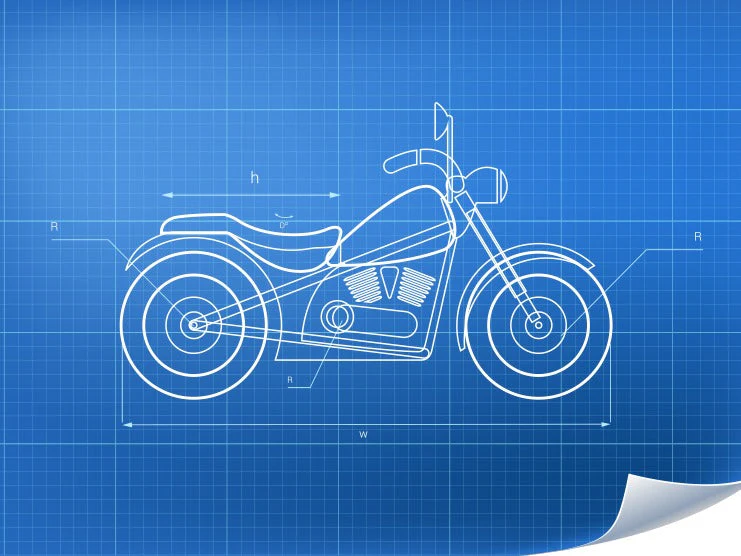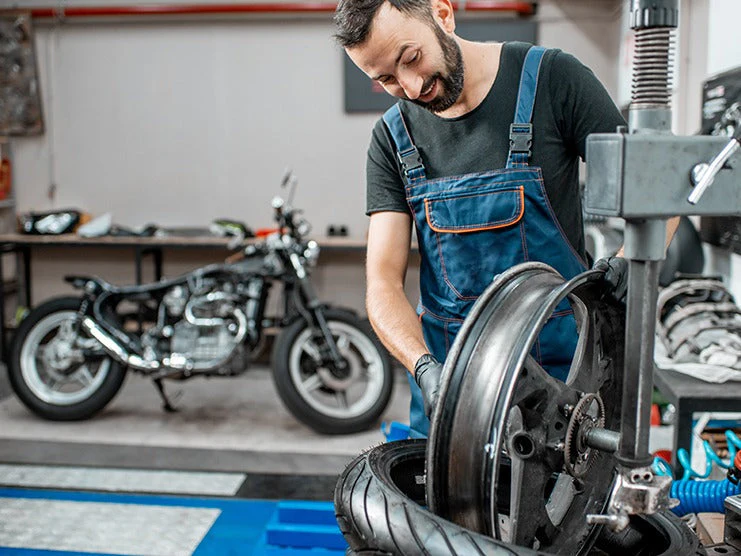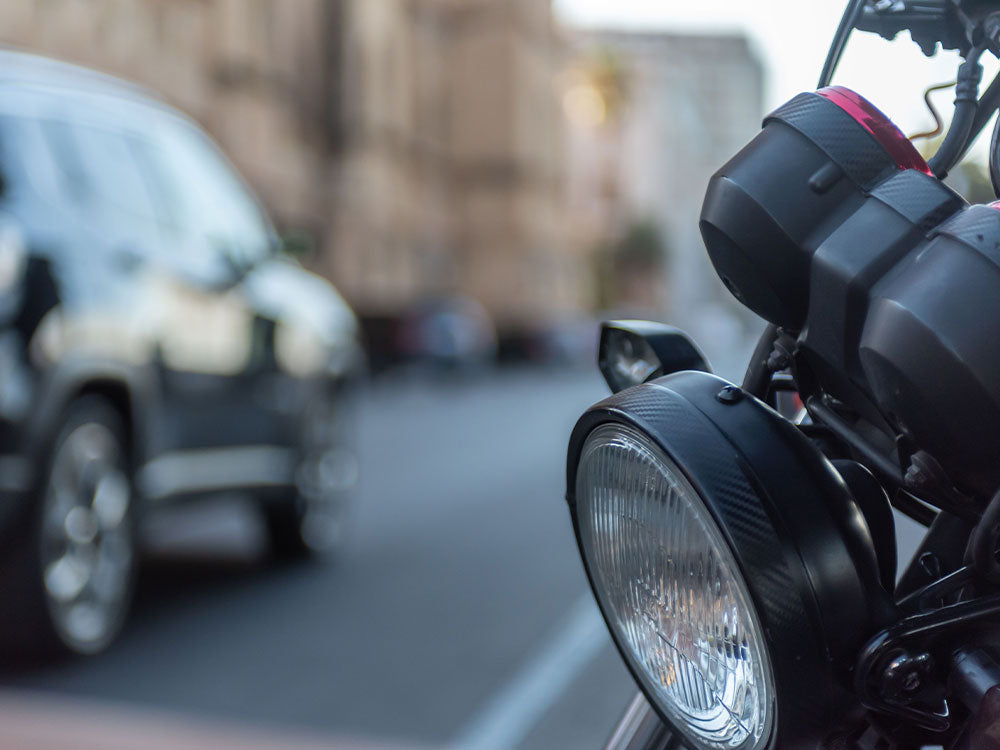Motorcycle geometry is an intricate subject that covers the different dimensions that determine the vehicle’s overall design. Any modifications or adjustments you make to your motorcycle can significantly impact its handling.
This article will serve as a guide on motorcycle geometry and handling.
Table of Content
1. Motorcycle Geometry
Motorcycle geometry involves the two areas of the motorcycle: the front and rear geometry.
1.1 Front Geometry
Offset
The offset measures the distance from the steering axis to the front axle’s center line. In other words, it is the distance from the fork center line to the steering stem. It is often set and controlled by the triple clamp fork, which puts the fork at a predetermined distance from the steering axis.
Rake
The rake is the angle made by the steering axis with a vertical center line through the front wheel to the contact patch. The rake angle is determined by the height and mount of the frame's steering axis.
Trail
The trail is the measurement between the vertical front wheel center line and the extrapolated line of the steering axis. The trail affects a bike's handling and stability on a road or track. You can increase the stability of the motorcycle by increasing the trail, but it will be harder to turn the bike when changing directions. The increased stability is particularly useful when traveling at high speeds.
Adjusting Trail
Adjusting the rake angle, offset, or front tire/wheel diameter are three basic methods to change the front wheel's trail.
The most simple way to adjust the trail on a street bike is by adjusting the ride height since there aren't many geometry-related components that can be adjusted on road bikes. However, modifying the rake angle by raising or reducing the ride height can negatively affect handling due to other motorcycle components being altered. This can result in the center of gravity being raised or lowered, which can affect how the bike changes directions. Moreover, adjusting the ride height can also change the static loads of the front and back wheels, changing how the bike will respond to braking and throttle input. The ride height can be changed at the front by moving the triple clamp fork up or down, and at the rear by adjusting the length of the rear shocks.
To increase the trail at the front wheel, you’ll need to raise the front and lower the rear of the bike. If you alter the ride height by 4-5 mm, you’ll see a 1 mm change in the trail. So to produce a noticeable change in the length of the trail, you need to make a significant change in the ride height.
The trail on racing bikes can be changed by making fine adjustments to the adjustable triple clamp, changing the offset distance, and improving handling. To make these adjustments, you can buy aftermarket triple clamps that remove the need to change the ride height.
To increase the trail, you can make the following adjustments:
- Increase Rake Angle
- Decrease the Offset Distance
- Install a Bigger Front Tire
- Raise the Front Ride Height
- Reduce the Rear Ride Height
Effects of Adjusting Trail
Adjustments to the trail via rake angle or offset will directly affect the bike’s stability. Stability is important when cornering and hitting dips or bumps.
Why You Need to Adjust Trail
A longer trail” will increase the stability of your motorcycle by increasing the center of gravity at the front tire. This is essential on long roads where you want your motorcycle to stay in a straight line. A longer trail will also allow your motorcycle to travel over bumpy roads more smoothly. However, a longer trail also means that it will be harder to steer your bike. Your motorcycle will be unable to change directions quickly and will feel heavy when handling.
If you give your motorcycle a shorter trail, the bike will require less effort to change directions. The bike will feel more responsive and lighter when steering. However, riders will find it harder to keep their bike in a straight line when riding over bumpy roads. As a result, it might be dangerous to set up a road bike with race bike geometry as obstacles like potholes and road bumps are not present on the race circuit.
1.2 Rear Geometry
Anti-Squat
The squat refers to the tendency of the rear suspension to compress when weight shifts to the back of the motorcycle. The anti-squat is the tendency for the rear suspension to extend during acceleration. As motorcycles produce a more powerful output, the effects of squats and anti-squat on the handling becomes more noticeable.
Both forces are responsible for the anti-squat effect. The squat is the driving force of the rear tire, which slopes up the swingarm from the rear wheel to the pivot and extends the rear suspension. The upward angle of the swingarm would cause the rear wheel suspension to extend. The anti-squat is responsible for the rear suspension extending due to the chain pulling on the axle in a parallel direction to the top chain run. The extent of the anti-squat effect due to the chain pulling depends on how far the chain stretches from the swingarm pivot and the angle of the chain relative to the swingarm.
Adjusting Anti-Squat
Adjusting the anti-squat involves changing the parameters that affect the chain angle or swingarm angle. That means lowering or raising the back end to change the swingarm angle, altering the gears to change the distance from the pivot or chain angle, or changing the pivot location to alter the anti-squat effect.
If you want to increase the anti-squat effect, you’ll need to raise the rear ride height to increase the swingarm angle; raise the swingarm pivot; fit shorter gearing to change the swingarm-chain relationship. Keep in mind that you must fit the gearing with a different ratio, not just smaller or bigger sprockets with the same ratio.
2. Motorcycle Handling
2.1 Common Motorcycle Handling Issues
Low Tire Pressure
The motorcycle tires should be inflated to the correct tire pressure as stated by your service manual. Poorly inflated tires can lead to the tires being worn, poor traction, and unstable steering.
Leaks in Suspension
Leaks in the suspension can cause poor handling and damping. It should be resolved at your dealership shop or any other reputable shop.
Misaligned Rear Tire
A misaligned rear tear is often due to the rear tire being worn down or after incorrectly adjusting the chain slack or removing and reinstalling the rear tire. This can cause your motorcycle to turn sharply towards either direction and makes it difficult to travel straight. With the right tools, you can realign the rear tire at home within 15 minutes. Be sure to follow all the instructions in your service manual.
Misaligned Forks
If your motorcycle still does not handle smoothly when turning corners or traveling in a straight line, consider looking at the alignment of the front fork. Your motorcycle fork can become misaligned after traveling over a bump, suffering a fall, improper assembly of the front suspension, or wear and tear over time. To fix a misaligned fork, you need to loosen the bolts at the base of the triple clamp, hop on the bike, grasp the front brakes, and pump on the forks using your weight. Keep your motorbike standing straight after a few pumps and then tighten the bolts of the triple clamp. For the best results, keep your motorcycle upright when the clamps are being tightened.
Worn Out or Old Tires
You may experience poor handling if the tires are old or worn out. A motorcycle tire generally expires five years after its production date. You can find the manufacturing date on the side of the tire wall. Worn-out tires can lead to poor braking and acceleration, the tires sliding or slipping, or difficulty keeping the motorcycles straight. Unevenly worn-out tires typically come in scalloped or cupped tires that have tire wear between the right and left portions of the tire, or squared-off tires that have a flat center band. These kinds of patterns are dangerous to the bike’s handling. You’ll need to replace them with new tires in order to get ideal handling.
2.2 Improving Handling
When it comes to enhancing your bike's handling qualities, most people talk about tires and suspension configuration. While all of these things have a significant impact on how your motorbike handles, it's actually the chassis geometry that has a far greater impact. Customizing these settings can significantly change how your bike handles.
In general, a motorbike will turn more quickly and will require less effort to change directions if its front end is lowered or its back is raised. On the other hand, if the front is raised and the rear is lowered, the responsiveness of the steering will be affected.
There isn't an ideal setup for any one bike because it actually relies on the preferences of the individual rider. Sport riders like to be able to change direction rapidly without exerting a lot of effort on the bars while touring and cruising riders typically choose more stability.
When making adjustments to achieve a balance between stability and responsiveness, it is best to make changes in small increments.
Keep in mind that adjusting the spring preload will have a substantial impact on handling, in addition to determining how much wheel travel is available for compression and extension. That’s the reason why sag does not have a fixed value but rather a range of 28% to 33% of the entire wheel travel.
3. Last Words
The motorcycle geometry has a significant impact on how well the motorcycle handles. You can make adjustments to the geometry to make the handling better. This article discussed how you can make adjustments to your motorcycle, common motorcycle handling problems, and how to improve motorcycle geometry and handling. Viking Bags has several modification options available, including sissy bars, fairings, crash bars, and handlebars. There are also many luggage options available, including sissy bar bags and motorcycle saddlebags for a better motorcycle riding experience.













Leave a comment
All comments are moderated before being published.
This site is protected by hCaptcha and the hCaptcha Privacy Policy and Terms of Service apply.